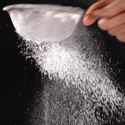Deuterium outruns hydrogen in diffusion race
Separation by molecular sieving in narrow windows of microporous and nanoporous materials consisting of cagelike frameworks of atoms is normally governed by the relative sizes of the diffusing molecules. However, for isotopes, such molecular sieving is precluded from a classical viewpoint as they are of similar size and shape.
In 2005, Anil Kumar and Suresh Bhatia from the University of Queensland, Australia, used atomistic molecular dynamics simulations to study the diffusion of and in a microporous material. They predicted that transport diffusivities would be reduced by quantum interactions, and that would diffuse significantly faster than in quantum confined systems at low temperatures [1]. Now, in a paper appearing in Physical Review Letters, Than Nguyen and Suresh Bhatia from the University of Queensland, and Hervé Jobic from the Université Lyon, France, use quasielastic neutron scattering to observe this reverse kinetic molecular sieving at a microscopic level for temperatures below .
With the development of optimal sieving materials, the process may be used to separate light isotopes, including and . – Jane Throwe
[1] A.V. Anil Kumar and Suresh K. Bhatia, Phys. Rev. Lett. 95, 245901 (2005).





